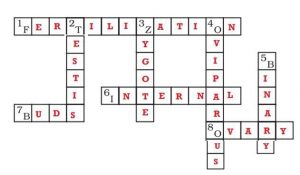9.2 QUESTIONS IN EXERCISE:
1. Explain the importance of reproduction in organisms.
Ans: Reproduction is essential for the continuation of a species. It ensures the continuation of similar kinds of individuals, generation after generation.
2. Describe the process of fertilization in human beings.
Ans: There is sexual reproduction in human beings. Male reproductive organs produce sperms (male gametes) while the female gametes produce ova (female gametes). The sperms are ejected inside female bodies where they fuse with ovum and forms zygote (called internal fertilization). The zygote begins to develop into an embryo which attaches to the female uterus wall. The embryo further multiples into many cells and develops further into a small baby called foetus.
3. Choose the most appropriate answer:
(a) Internal fertilization occurs :
(i) In female body (ii) Outside female body (iii) In male body (iv) Outside male body.
(b) A tadpole develops into an adult frog by the process of
(i) Fertilization (ii) Metamorphosis (iii) Embedding (iv) Budding.
(c) The number of nuclei present in a zygote is
(i) None (ii) One (iii) Two (iv) Four.
Ans:
(a) (i) In female body (b) (ii) Metamorphosis (c) (ii) One.
4. Indicate whether the following statements are True (T) or False (F):
(a) Oviparous animals give birth to young ones. ( )
(b) Each sperm is a single cell. ( )
(c) External fertilization takes place in frog. ( )
(d) A new human individual develops from a cell called gamete. ( )
(e) Egg laid after fertilization is made up of a single cell. ( )
(f) Amoeba reproduces by budding. ( )
(g) Fertilization is necessary even in asexual reproduction. ( )
(h) Binary fission is a method of asexual reproduction. ( )
(i) A zygote is formed as a result of fertilization. ( )
(j) An embryo is made up of a single cell. ( )
Ans:
(a) Oviparous animals give birth to young ones. (False)
(b) Each sperm is a single cell. (True)
(c) External fertilization takes place in frog. (True)
(d) A new human individual develops from a cell called gamete. (False)
(e) Egg laid after fertilization is made up of a single cell. (True)
(f) Amoeba reproduces by budding. (False)
(g) Fertilization is necessary even in asexual reproduction. (False)
(h) Binary fission is a method of asexual reproduction. (True)
(i) A zygote is formed as a result of fertilization. (True)
(j) An embryo is made up of a single cell. (False)
5. Give two difference between a zygote and a foetus.
Ans: Zygote is single cellular whereas foetus is a multicellular.Well defined body parts are absent in zygote whereas in foetus body parts can be identified .
6. Define asexual reproduction. Describe two methods of asexual reproduction in animals.
Ans: Asexual reproduction is a mode of reproduction in which only one parent is involved to reproduce offspring. In asexual reproduction, the off springs produced are exact copies of their parents. It is generally observed in very small sized organisms. Binary fission, Budding, Fragmentation etc. are the examples of asexual reproduction. Budding: In this mode, a part of the organism starts bulging out. Slowly it grows and develops into a separate individual. Examples: Hydra, yeast. Binary Fission: It is a type of asexual reproduction in which a single cell divides into two halves. Organisms that reproduce through binary fission are bacteria and Amoeba.
7. In which female reproductive organ does the embryo get embedded.
Ans: In walls of the uterus.
8. What is metamorphosis. Give examples.
Ans: The transformation of the larva into an adult through drastic changes is called metamorphosis. Metamorphosis is a biological process which involves sudden and abrupt changes in the body structure of the animal by cell growth and differentiation. It is generally observed in amphibians and insects.
Examples: frogs and butterflies .
9. Differentiate between internal fertilization and external fertilization.
Ans:
| Sr. No. | Internal Fertilization | External Fertilization |
| 1. | Fusion of male and female gametes take place inside the body. | Fusion of male and female gametes take place outside the body . |
| 2. | Less numbers of eggs are produced. | Large numbers of eggs are produced. |
| 3. | Examples: Cow, Dog, Human etc. | Examples: Frog, Fishes etc. |
10. Complete the cross-word puzzle using the hints given below :

Across :
1. The process of the fusion of the gametes.
6. The type of fertilization in hen.
7. The term used for bulges observed on the sides of the body of Hydra.
8. Eggs are produced here.
Down :
2. Sperms are produced in these male reproductive organs.
3. Another term for the fertilized egg.
4. These animals lay eggs.
5. A type of fission in amoeba.
Ans:


